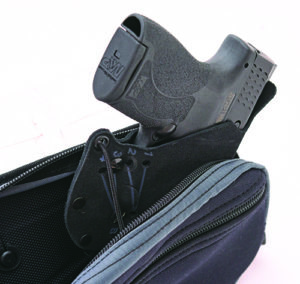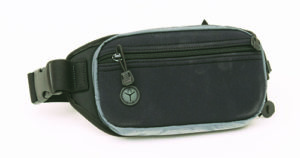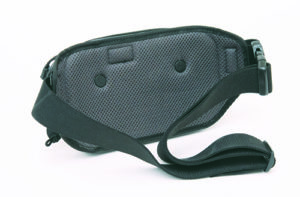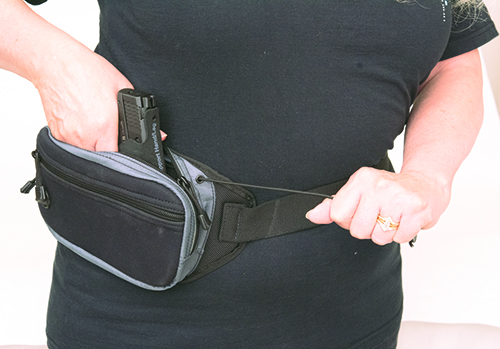Concealed carry via a waistpack or “fanny pack” could be defined as a method of transporting a handgun in a compartment suspended from a belt separate from any belt or other means worn to suspend a pair of pants or a skirt. At once we are reminded of the typical Old West gunfighter’s belt strapped across the hips, describing a diagonal line weighed down by one’s choice of shooting iron. Indeed, the shortcomings of a fanny pack or waistpack carry begin with an obvious “tell,” wherein the presence of something heavy and incongruous has been added to one’s waistline. Galco Gunleather’s $99 FasTrax PAC takes on the challenge of making the fanny pack less conspicuous while offering multiple ways to put the firearm into play.
The FasTrax PAC consisted of a main compartment measuring 8.7 inches long by 5.2 inches high; width unloaded is a mere 1.5 inches wide. The main compartment was revealed via a two-way zipper that lies open approximately the upper half of its rectangular shape. There was also a zippered compartment on the outer face ideal for ID cards or a thin radio or iPod. A pass-through device for headphone wires was in place. The support belt offered a maximum length of 50 inches plus 7 inches of stretch. The belt could, however, be cinched down to as little as 20 inches in circumference, making it possible to be attached to a pole, the bars of an ATV, or other stationary object. But that would be missing the point. The space-age material that allows the FasTrax PAC to hug the body without drooping and move with the operator is a key advantage over other designs. We also found that the unit did not cause us to sweat behind the back panel of the main compartment or along the belt line.

We’re not sure if Galco revisited fanny-pack carry because new materials made it more viable or the company was intrigued with producing a quick-draw holster that rotates the gun into the hand with the pull of “string.” We think the FasTrax holster certainly makes it more fun, if not a lot faster. The holster itself enveloped all but the grip and included a hard lower frame that is adjustable to several specific models of handgun. This includes any number of small-frame revolvers, such as the Smith & Wesson J-frames to the Ruger LCR series, the Taurus 85/605 and the Charter Bulldog revolvers, plus a variety of small semi-automatic pistols. More than 26 firearms are listed in the owners manual. The holster stabilizes the gun via an adjustable welt “sandwiched between the walls of the holster and positioned to cradle the trigger guard.” Four different positions are clearly illustrated in the owner’s manual to accommodate different handguns. The welt was positioned by two “Chicago” screws, one fore and one aft. The forward screw holes were designated letters A through C. The rearward screw holes were numbered 1 through 4. For example, to accommodate our 9mm Smith & Wesson Shield 2.0, we mounted the welt using the combination 3B.

The procedure of opening the main compartment by pulling on the zipper tab to open the top of the pack, then tugging the activation cord to rotate the gun into the hand, was not as complicated or as time-consuming as it may sound. To test, we used an unloaded Smith & Wesson Shield and an unloaded Ruger LCP drawn in a series of 10 dry-fire sequences against a shrinking maximum time limit (PAR time). The timer provided both an audible start and an audible stop signal. Start position was with the strong (gun) hand on the top zipper and the support hand holding the ripcord tucked innocently inside the belt. The sequence ended when the trigger was pulled. In this facsimile of an emergency draw, results showed that our team members were able to draw, push the gun forward, and snap the trigger within a time period of 1.5 to 2.0 seconds.

As contrived as the start position in our action test might sound, one’s intention could conceivably be masked by a nonchalant, hands-on-belt posture. Bear in mind that there are also many more situations in everyday life that do not demand a quick draw. For example, when walking to one’s car in a darkened parking lot after a late night at the office, it’s not unusual for someone to place his hand on his firearm while it is still in concealment, such as a hand inside the pocket or inside a bag. The FasTrax PAC excels at this level of readiness because the holster safely retains the gun even when the main zipper is completely open. In addition, the gun can be drawn without pulling the cord, leaving the support hand free to attend to other chores such as open a door, push an innocent out of the way, or fend off an attacker. Digging the hand inside the main compartment was safe because the trigger guard remained covered until the gun was completely free of the pack.
Our Team Said: We sometimes forgot we were wearing the FasTrax PAC because it didn’t sag and moved instinctively with the wearer. We were split on using the activation cord to bring the gun into action. Some of us thought it was a gimmick, albeit one that actually worked. But we all agreed that the rotating holster was an excellent feature that provided security as well as speed. Men and women on our team agreed they should have a Galco FasTrax PAC in their arsenal.




























Been a Gun Tests subscriber for years. Without advertisers to please, it’s a breath of fresh air in the gun review world. Just wanted to add some other choices to this review of the Galco FasITrax.
I got a Sneaky Pete for my LCP II which is equipped with a Reactor laser. This particular model holster is unusual for having 3 magnets holding down the cover. This laser is turned off in a holster by a holster-mounted magnet and I’ve found that the Sneaky Pete arrangement, unknown to them, will turn the laser off, something the normal 2 magnet probably won’t do. That said, I haven’t worn the Sneaky Pete much. Not that it screams “gun” but I think it’s a little too obvious. Probably should have gotten a more neutral color than black. In addition the gun pressed against the hard back makes it difficult to get your fingers around the grip. I find I have to pull the gun out a little before I can really grab it.
My preferred carry bag is an Elite Survival Systems “Liberty Gun Pack” in Coyote Tan. Besides the holster area it has two other compartments plus a cell phone holder. It swallows my Walther PPS M2 and a spare mag in the same compartment but I find that I have to use the shorter 6 round magazine as the reload to, once again, allow me room in the compartment to wrap my fingers around the grip before pulling. The quick-draw tabs don’t seem to work for me. I have put a small metal key ring instead of the tied draw string on one of the two zipper pulls that close the holster compartment. When there is a string on both there’s a tendency to grab both and pull them together, leaving the compartment closed. I would like to wear it horizontally on my belt but that would put the muzzle horizontal instead of down, not a good thing. All that said, I’ve taken the holster to some of my every day carry drill classes and find it to not only work one handed but be just as fast as when I have to deal with a shirt and other clothing to get to the gun. I’ve worn it hiking and around town and no one has ever looked twice at it. Definitely a keeper.